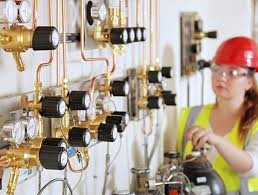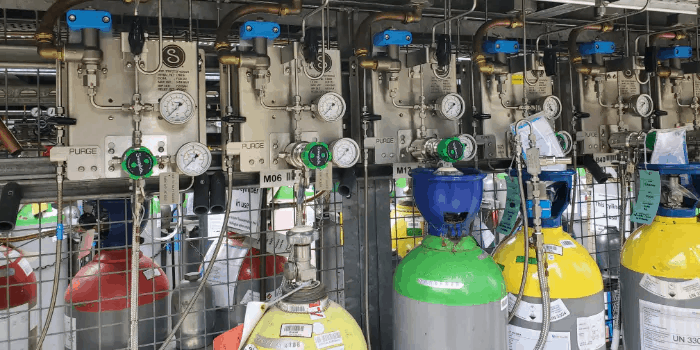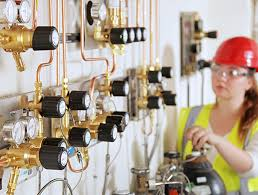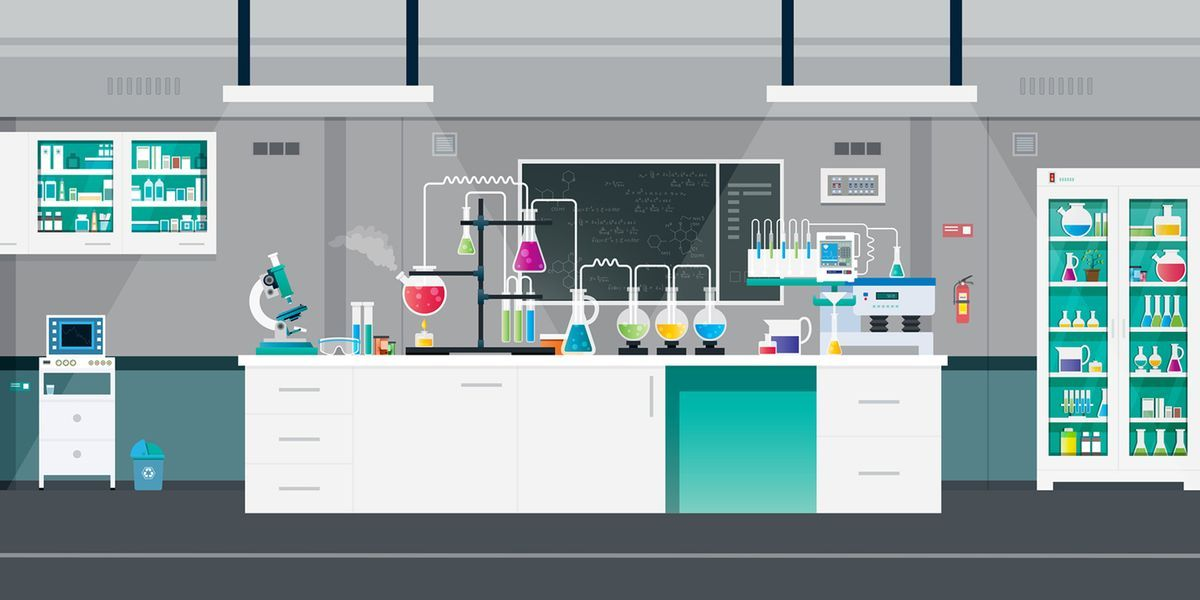Sizing gas distribution systems for lab demand

Optimizing Lab Gas Flow: A Comprehensive Guide to Sizing Gas Distribution Systems

In the realm of scientific research and development, laboratories serve as the bedrock of innovation, where groundbreaking discoveries are made and cutting-edge technologies are developed. These laboratories are often equipped with sophisticated instruments and equipment that rely on a steady and reliable supply of gases, such as nitrogen, oxygen, hydrogen, helium, and argon. These gases are essential for a wide range of applications, including chromatography, mass spectrometry, laser spectroscopy, and cell culture. The efficient and safe delivery of these gases to the point of use is paramount to ensuring the accuracy, precision, and reproducibility of experimental results.
The design and implementation of a robust and efficient gas distribution system is a critical aspect of laboratory infrastructure. A well-designed system ensures that the required gases are delivered at the appropriate pressure, flow rate, and purity to meet the specific demands of each instrument and application. However, the complexity of modern laboratories, with their diverse range of instruments and varying gas requirements, presents a significant challenge in optimizing gas flow. This challenge is further compounded by the need to ensure safety and compliance with regulatory standards.
The sizing of gas distribution systems is a crucial step in optimizing lab gas flow. An undersized system can lead to inadequate gas delivery, resulting in instrument performance issues, compromised experimental results, and potential safety hazards. Conversely, an oversized system can result in unnecessary capital expenditure and increased operating costs. Therefore, a comprehensive understanding of the factors influencing gas demand and the principles of gas distribution system design is essential for achieving optimal gas flow in laboratories.
This article delves into the intricacies of sizing gas distribution systems for lab demand, providing a comprehensive guide for lab technicians, project managers, procurement managers, and C-suites in the scientific industry. We will explore the key considerations for determining gas demand, the principles of gas distribution system design, and the best practices for ensuring optimal gas flow. By understanding these concepts, you can make informed decisions regarding the design, installation, and maintenance of your laboratory's gas distribution system, ultimately contributing to the efficiency, safety, and success of your research endeavors.
The article will address the following key aspects:
- Understanding Gas Demand: This section will delve into the factors influencing gas demand in laboratories, including the types of instruments and applications, gas flow rates, and pressure requirements. We will also discuss the importance of considering future expansion plans and the potential for increased gas demand.
- Gas Distribution System Design Principles: This section will explore the fundamental principles of gas distribution system design, including the selection of appropriate piping materials, fittings, and regulators. We will also discuss the importance of pressure drop calculations, flow rate considerations, and safety features.
- Sizing Gas Distribution Systems: This section will provide practical guidance on sizing gas distribution systems based on the specific gas demand of your laboratory. We will cover the use of industry-standard sizing tools and software, as well as the importance of conducting flow tests and commissioning the system.
- Best Practices for Optimal Gas Flow: This section will highlight best practices for ensuring optimal gas flow in laboratories, including regular maintenance, leak detection, and the use of gas monitoring systems. We will also discuss the importance of training personnel on safe gas handling procedures.
By addressing these key aspects, this article aims to provide a comprehensive understanding of the principles and best practices for sizing gas distribution systems for lab demand. This knowledge will empower you to make informed decisions that optimize gas flow, enhance laboratory efficiency, and ensure the safety of your research environment.
The Crucial Role of Gas Piping & Distribution Systems in Laboratory Operations
In the realm of scientific research and development, laboratories serve as the bedrock of innovation, where groundbreaking discoveries are made and technological advancements are driven. At the heart of these laboratories lies a critical infrastructure element: gas piping & distribution systems. These systems are the lifeblood of numerous scientific processes, providing a reliable and controlled supply of gases essential for a wide range of applications.
From the delicate manipulation of gases in analytical chemistry to the precise control of atmospheres in material science, gas piping & distribution systems play a pivotal role in ensuring the accuracy, reproducibility, and safety of laboratory operations. The efficient and reliable delivery of gases is paramount to achieving accurate experimental results, maintaining the integrity of research data, and safeguarding the well-being of laboratory personnel.
The complexity and sophistication of modern scientific research demand gas piping & distribution systems that are meticulously designed, installed, and maintained. These systems must meet stringent safety standards, accommodate diverse gas requirements, and provide seamless integration with laboratory equipment. The selection and implementation of appropriate gas piping & distribution systems are crucial decisions that directly impact the efficiency, productivity, and overall success of laboratory operations.
Understanding the Importance of Gas Piping & Distribution Systems
Gas piping & distribution systems are the backbone of laboratory operations, providing a reliable and controlled supply of gases essential for a wide range of scientific applications. These systems are responsible for:
- Delivery of Gases: Gas piping & distribution systems transport gases from their source, such as cylinders or bulk tanks, to various points of use within the laboratory. This includes delivering gases to analytical instruments, reaction vessels, furnaces, and other equipment that require a controlled gas supply.
- Gas Purity and Quality Control: The integrity of scientific experiments relies on the purity and quality of the gases used. Gas piping & distribution systems are designed to maintain the purity of gases throughout the delivery process, ensuring that the gases delivered to laboratory equipment meet the required specifications.
- Safety and Compliance: Gas piping & distribution systems are subject to stringent safety regulations and industry standards. These systems are designed to prevent leaks, explosions, and other hazards associated with the handling of gases. They incorporate safety features such as pressure relief valves, leak detection systems, and emergency shut-off valves to ensure the safety of laboratory personnel and the environment.
- Flexibility and Scalability: Laboratories often require a diverse range of gases for different applications. Gas piping & distribution systems are designed to be flexible and scalable, allowing for the addition or modification of gas lines to accommodate changing research needs. This flexibility ensures that laboratories can adapt to evolving research requirements without compromising the integrity of their gas infrastructure.
The Challenges of Designing and Implementing Gas Piping & Distribution Systems
Designing and implementing gas piping & distribution systems for laboratories present a unique set of challenges that require careful consideration and expertise. These challenges include:
- Gas Compatibility: Different gases have different properties and require specific materials and design considerations for safe and efficient handling. For example, corrosive gases may require specialized piping materials to prevent corrosion and leaks. The compatibility of gases with the materials used in the piping system is crucial to ensure the integrity and longevity of the system.
- Pressure and Flow Rate Requirements: Laboratory equipment often has specific pressure and flow rate requirements for optimal performance. Gas piping & distribution systems must be designed to deliver gases at the required pressure and flow rates to meet the needs of various instruments and processes. This involves careful selection of piping materials, diameters, and flow control devices to ensure accurate and consistent gas delivery.
- Safety and Regulatory Compliance: Gas piping & distribution systems are subject to stringent safety regulations and industry standards. These regulations dictate the materials, design, installation, and maintenance practices for gas piping systems to minimize the risk of leaks, explosions, and other hazards. Compliance with these regulations is essential to ensure the safety of laboratory personnel and the environment.
- Space Constraints: Laboratories often have limited space, which can pose challenges for the installation and routing of gas piping systems. The design of gas piping systems must take into account the available space, the location of gas sources and points of use, and the need for easy access for maintenance and repairs.
- Cost Considerations: The cost of designing, installing, and maintaining gas piping & distribution systems can be significant. It is important to balance the cost of the system with the long-term benefits of a reliable and safe gas infrastructure. Careful planning and consideration of different system options can help optimize the cost-effectiveness of gas piping & distribution systems.
Key Considerations for Sizing Gas Distribution Systems
Sizing gas distribution systems for laboratory demand is a critical step in ensuring the efficient and reliable delivery of gases to laboratory equipment. The size of the system, including the diameter of the piping and the capacity of the gas source, must be carefully calculated to meet the anticipated gas demand. This involves considering factors such as:
- Gas Consumption Rates: The gas consumption rates of individual laboratory instruments and processes must be determined to estimate the total gas demand of the laboratory. This information can be obtained from instrument manuals, gas suppliers, or by conducting flow rate measurements.
- Number of Gas Outlets: The number of gas outlets required for the laboratory must be considered to ensure that there are sufficient points of use for all equipment and processes. The location of these outlets should be strategically planned to minimize the length of gas lines and optimize the distribution of gases.
- Gas Pressure Requirements: The pressure requirements of laboratory equipment must be taken into account when sizing the gas distribution system. The system must be designed to deliver gases at the required pressure to ensure the proper operation of instruments and processes.
- Gas Purity Requirements: The purity requirements of gases used in laboratory applications must be considered when selecting gas sources and designing the gas distribution system. The system should be designed to minimize the introduction of contaminants and maintain the purity of gases throughout the delivery process.
- Future Expansion: It is important to consider future expansion plans when sizing the gas distribution system. The system should be designed with sufficient capacity to accommodate future growth in gas demand and the addition of new equipment or processes.
Types of Gas Piping & Distribution Systems
Gas piping & distribution systems are available in a variety of configurations to meet the specific needs of different laboratories. The choice of system depends on factors such as the types of gases used, the gas consumption rates, the pressure requirements, and the budget. Some common types of gas piping & distribution systems include:
- Centralized Gas Distribution Systems: Centralized systems are typically used in large laboratories with high gas demand. These systems involve a central gas source, such as a bulk tank or a bank of cylinders, from which gas is distributed to various points of use throughout the laboratory. Centralized systems offer advantages such as centralized control, efficient gas management, and reduced maintenance costs.
- Decentralized Gas Distribution Systems: Decentralized systems are often used in smaller laboratories or for specific applications where a central gas source is not feasible. These systems involve individual gas cylinders or small gas generators that are located near the point of use. Decentralized systems offer flexibility and ease of installation but may require more frequent cylinder changes or generator maintenance.
- Manifold Systems: Manifold systems are used to distribute gases from multiple sources to multiple points of use. These systems typically involve a manifold, which is a device that combines multiple gas lines into a single outlet. Manifold systems offer flexibility and redundancy, allowing for the use of multiple gas sources and the ability to switch between sources if one fails.
- Gas Panel Systems: Gas panel systems are pre-engineered systems that provide a comprehensive solution for gas distribution in laboratories. These systems typically include a gas panel, which is a cabinet that houses gas regulators, valves, and other components for controlling and distributing gases. Gas panel systems offer convenience, safety, and ease of installation.
Materials Used in Gas Piping & Distribution Systems
The materials used in gas piping & distribution systems are critical to ensuring the safety, reliability, and longevity of the system. The choice of materials depends on the types of gases used, the pressure and temperature requirements, and the environmental conditions. Some common materials used in gas piping & distribution systems include:
- Copper: Copper is a durable and corrosion-resistant material that is commonly used for gas piping systems. It is suitable for a wide range of gases, including nitrogen, oxygen, and argon. However, copper can be susceptible to corrosion in the presence of certain gases, such as chlorine and sulfur dioxide.
- Stainless Steel: Stainless steel is a highly corrosion-resistant material that is suitable for handling a wide range of gases, including corrosive gases. It is also resistant to high temperatures and pressures, making it a good choice for applications where these conditions are present.
- Polyethylene (PE): Polyethylene is a lightweight and flexible material that is often used for gas piping systems. It is resistant to corrosion and chemicals, making it suitable for handling a variety of gases. However, PE piping is not as strong as copper or stainless steel and may not be suitable for high-pressure applications.
- Polyvinyl Chloride (PVC): PVC is a durable and inexpensive material that is commonly used for gas piping systems. It is resistant to corrosion and chemicals, making it suitable for handling a variety of gases. However, PVC piping is not as strong as copper or stainless steel and may not be suitable for high-pressure applications.
Safety Considerations for Gas Piping & Distribution Systems
Safety is paramount when designing, installing, and maintaining gas piping & distribution systems. These systems must be designed and operated to minimize the risk of leaks, explosions, and other hazards associated with the handling of gases. Some key safety considerations include:
- Leak Detection: Leak detection systems are essential for identifying leaks in gas piping systems. These systems can be passive, such as leak detectors that monitor the atmosphere for the presence of gases, or active, such as leak detectors that inject a tracer gas into the system to identify leaks. Regular leak testing is crucial to ensure the safety of laboratory personnel and the environment.
- Pressure Relief Valves: Pressure relief valves are safety devices that are installed in gas piping systems to prevent excessive pressure buildup. These valves open automatically when the pressure in the system exceeds a predetermined limit, releasing gas to the atmosphere to prevent explosions or other hazards.
- Emergency Shut-Off Valves: Emergency shut-off valves are manual valves that are installed in gas piping systems to allow for the rapid isolation of gas flow in case of an emergency. These valves should be easily accessible and clearly marked to ensure that they can be quickly and safely operated in the event of a leak or other hazard.
- Ventilation: Adequate ventilation is essential for laboratories that use gases. Ventilation systems should be designed to remove gases from the laboratory atmosphere and prevent the buildup of hazardous concentrations. The ventilation system should be regularly inspected and maintained to ensure its effectiveness.
- Training and Awareness: Laboratory personnel should be properly trained in the safe handling of gases and the operation of gas piping & distribution systems. This training should include information on leak detection, emergency procedures, and the proper use of safety equipment.
Maintenance and Inspection of Gas Piping & Distribution Systems

Regular maintenance and inspection of gas piping & distribution systems are essential to ensure the safety, reliability, and longevity of the system. This includes:
- Visual Inspections: Regular visual inspections should be conducted to identify any signs of damage, corrosion, or leaks in the piping system. This includes checking for cracks, dents, rust, or other signs of deterioration. Any damage or leaks should be repaired immediately.
- Leak Testing: Leak testing should be conducted regularly to identify any leaks in the piping system. This can be done using a variety of methods, such as soap bubble testing, electronic leak detectors, or tracer gas testing.
- Pressure Testing: Pressure testing should be conducted periodically to ensure that the piping system can withstand the operating pressure. This involves pressurizing the system to a predetermined level and monitoring for leaks or other signs of failure.
- Valve Inspection: Valves in the gas piping system should be inspected regularly to ensure that they are operating properly. This includes checking for leaks, corrosion, or other signs of damage. Any faulty valves should be repaired or replaced.
- Gas Cylinder Inspection: Gas cylinders should be inspected regularly to ensure that they are in good condition and that the valves are operating properly. This includes checking for leaks, corrosion, or other signs of damage. Any damaged cylinders should be removed from service.
Conclusion
Gas piping & distribution systems are essential infrastructure elements in laboratories, providing a reliable and controlled supply of gases for a wide range of scientific applications. The design, installation, and maintenance of these systems are critical to ensuring the safety, efficiency, and productivity of laboratory operations. By carefully considering the factors discussed in this article, laboratories can ensure that their gas piping & distribution systems meet their specific needs and contribute to the success of their research endeavors.
Optimizing Gas Distribution Systems for Laboratory Efficiency
The intricate dance of gas distribution systems within laboratories is a critical element for ensuring research integrity, safety, and operational efficiency. This article has delved into the complexities of sizing these systems, highlighting the importance of accurate calculations, meticulous planning, and a comprehensive understanding of lab-specific demands. By carefully considering factors like gas type, flow rates, pressure requirements, and the unique needs of each research area, laboratories can achieve optimal gas distribution, minimizing downtime, maximizing productivity, and ensuring a safe and reliable research environment.
The journey towards a well-designed gas distribution system begins with a thorough assessment of current and future needs. This involves a meticulous analysis of the types of gases used, their flow rates, and the pressure requirements for various applications. A comprehensive understanding of the laboratory's layout, including the location of equipment and the potential for future expansion, is crucial for creating a system that can adapt to evolving research needs.
The selection of appropriate materials for gas piping and distribution systems is paramount. Factors like corrosion resistance, compatibility with different gases, and ease of installation must be carefully considered. The use of high-quality materials ensures the longevity and reliability of the system, minimizing the risk of leaks, contamination, and potential safety hazards.
Beyond the technical aspects, the importance of adhering to safety regulations and best practices cannot be overstated. Regular inspections, maintenance, and leak testing are essential for ensuring the safe and reliable operation of the gas distribution system. Proper training for laboratory personnel on the safe handling and use of gases is also crucial for preventing accidents and ensuring a secure research environment.
In conclusion, the optimization of gas distribution systems is a multifaceted endeavor that requires a holistic approach. By carefully considering the factors outlined in this article, laboratories can achieve a system that meets their specific needs, promotes safety, and enhances research efficiency.
IT Tech, a leading provider of lab consumables and equipment, understands the critical role of gas distribution systems in scientific research. We offer a comprehensive range of products and services designed to meet the unique needs of laboratories, from gas piping and distribution systems to specialized equipment and expert technical support.
Contact IT Tech today to discuss your specific requirements and explore how our expertise can help you optimize your gas distribution system for enhanced research efficiency and safety. Let us help you build a foundation for scientific excellence.
Subscribe to our newsletter
Stay updated with IT-Tech Insights
Related posts
Check out other IT- Tech Scientific Resources

Best practices for lab interior installation
This training guide delves into the best practices for laboratory interior installation, focusing on creating a functional and safe workspace. We cover key aspects like optimal layout design, strategic equipment placement, ergonomics, and compliance with safety regulations. Learn how to maximize space utilization, minimize workflow disruptions, and ensure a comfortable and productive environment for your researchers.

Resolving lab furniture and casework issues
Laboratory furniture and casework play a crucial role in the functionality and safety of any research facility. Over time, these elements can experience wear and tear, leading to various issues. This article offers a comprehensive guide to troubleshooting common problems, covering everything from drawer malfunctions to unstable work surfaces. By understanding the root causes and implementing effective solutions, you can ensure your lab furniture remains in optimal condition, promoting a productive and secure research environment. From identifying potential hazards to optimizing storage solutions, this guide empowers you to address issues proactively and maintain a high standard of laboratory operations.

Central vs localized lab vacuum systems
Choosing the right vacuum system for your research lab is crucial for efficient and safe operation. This article compares central and localized vacuum systems, analyzing their advantages and disadvantages. Central systems offer centralized control and shared resources, while localized systems provide individual control and flexibility. We discuss factors like cost, maintenance, safety, and application suitability to help you make an informed decision for your Public Health Engineering research needs.

























































.png)








